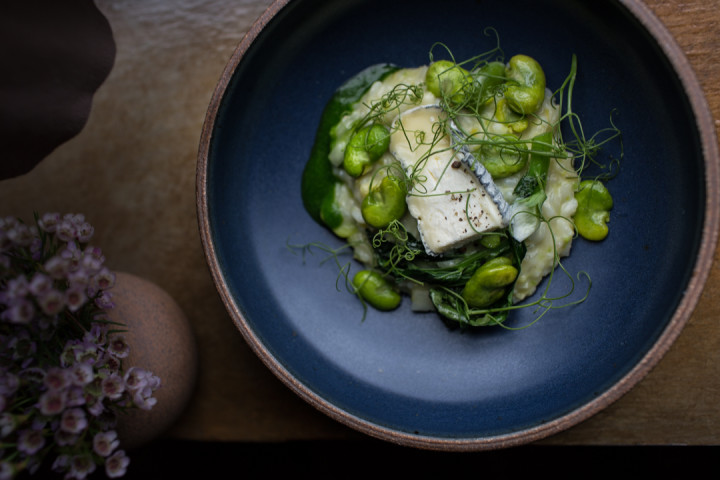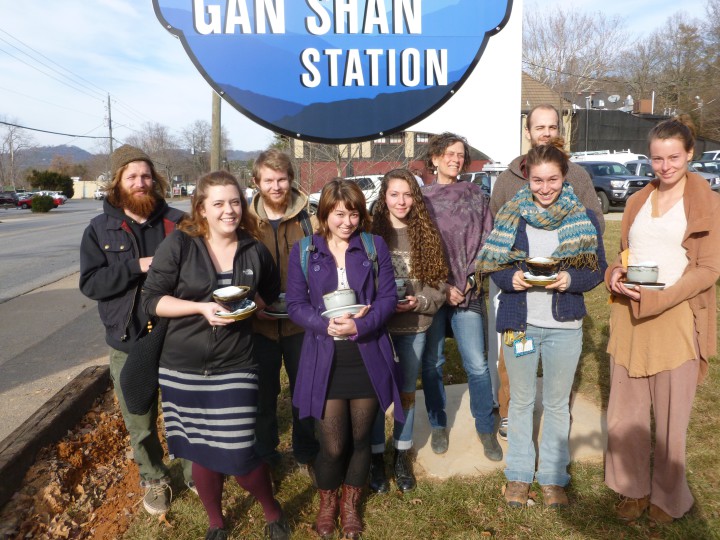Restaurateurs have long supported neighborhood artisans by enlisting them to create their signage and décor. But the ceramic vessels that hold Asheville’s locally sourced works of culinary art have largely remained standard-issue, industrially produced dinnerware.
While many chefs would undoubtedly prefer to present their fare on unique, handcrafted dishes, there are plenty of reasons — including everything from price points to practicality — why this can prove problematic. But in recent years, a new trend has been developing in Foodtopia.
Organic evolution
Working with restaurants is a major part of East Fork Pottery’s business plan, which has been evolving since potter Alex Matisse and his wife and business partner, Connie, founded the Marshall-based studio in 2010. Connie Matisse has a restaurant background (she used to be a manager at Table and has worked at restaurants in New York City and Los Angeles since the age of 15), and the couple have a love of good food. Plus, she says, “All of our friends in town are chefs or farmers. So it’s a perfect fit.”
It’s been just over two years since The Market Place chef and owner William Dissen kicked off East Fork’s food-industry collaborations with an order of shino-glazed dinner plates from the pottery’s 36-foot anagama wood-fired kiln. Since then, the Matisses have painstakingly refined their process to create a distinctive line of hand-thrown yet stackable and durable gas-fired stoneware dishes. They’ve also recently opened a retail space on Lexington Avenue and begun to massively scale up their production.

In Asheville, in addition to The Market Place, East Fork now also provides tableware to Cucina24, Curate, Gan Shan Station, Table and The Montford Rooftop Bar. Plus the small team of potters, led by Alex and operations and finance director John Vigeland, is busy with projects outside WNC, including a new coffee shop in Charleston, S.C., and accounts as far afield as Canada, the United Arab Emirates and Southern California.
“We get maybe 10 restaurant inquiries a week,” says Connie Matisse. “We wish we could fulfill them all, but there are only five people in the workshop. … It’s been hard to say no to some really cool-sounding projects.”
A major challenge for East Fork right now is increasing capacity while continuing to offer a high-quality, sturdy handmade product. It’s becoming fashionable throughout the industry for restaurants to use locally made pottery, says Matisse, “But a lot of other [ceramics] places use more industrialized processes. … Because our stuff is still thrown on the wheel, there’s only so much of it we can make. So we’re working out that equation.”
Size matters
For Cúrate co-owners Katie Button and Felix Meana, the desire to have customized tableware prompted them to seek locally made pottery last summer. “A big part of why we are using somebody local is because you can get whatever you want, whatever size is going to fit your concept,” Button explains.
The pair had struggled with finding the perfect-sized tapas plate for guests at Cúrate — most commercial dinnerware companies only sell plates that are 6 or 8 inches in diameter. “Six inches is just a little too small — but that’s what we’d gone with historically and just lived with it — and 8 inches is too big. … So having Alex make a 7-inch plate is awesome,” says Button.
Aesthetics were also a draw. “The things [Alex Matisse] does are so beautiful,” she says. “They’re rustically elegant, which is what we’re trying to do with our entire space.” Button and Meana spent time out at East Fork working with the potters on shapes and glazes to convey exactly what they wanted.
Button says she is now considering purchasing East Fork dishes in a different color palette for her other restaurant, Nightbell. And the soon-to-expand Cúrate is completely transitioning to Matisse’s pottery. “We’re still going to have a mix of wood and slate and those things, but as far as ceramics go, we’re slowly becoming 100 percent East Fork,” she says.
Practical things
The burgeoning demand for locally made dinnerware in Asheville’s swelling restaurant scene would seem to be a ripe opportunity for the area’s many ceramics artisans. But it’s not that simple, says Matisse.
“The challenge [for the individual potter] is making pots consistently in a way that restaurants can use,” she says. “They need to stack well, they need to fit in the dishwasher really, really well, they all need to look fairly similar … they all need to be the same size. So the consistency really has to be there, which is why I think a lot of potters don’t mess with it.”
It’s also a matter of interest, she points out. “Some people don’t want to be making the same pots all the time. But for us, that challenge is really the exciting part of it — really trying to dial things in and making them as perfect as we can.”
Laura Cooke, a potter at Clayspace Studio in the River Arts District, is dipping a toe into the waters of restaurant production: She was recently commissioned by Chestnut to make a series of plates for featuring daily specials.
Cooke has done other restaurant projects, including vases and singular items for Buxton Hall Barbecue and King Daddy’s Chicken & Waffles. But the Chestnut order has been trickier.
Some of the shapes requested are not part of her current production line, “so I’ve had to come up with how to make those,” she says. “I’m trying to make them aesthetically pleasing and also meet [the restaurant’s] specifications for size.” She has made several prototypes but is not yet satisfied with them.
Despite the initial hiccups with this order, Cooke says she would be interested in working more with the restaurant industry, but she’s not going to focus exclusively on that market. “It’s a nice kind of project,” she says, “but I’m not going to base my business model on trying to put my dishes in restaurants.”
Lunch and learn
Yet learning the skills necessary to produce dishware for restaurants could be an asset to up-and-coming potters. Since chef Patrick O’Cain opened his Pan-Asian eatery, Gan Shan Station, on Charlotte Street two years ago, he’s been regularly partnering with some budding clay artisans from Warren Wilson College. He works with instructor Leah Leitson to give participants in her upper-level ceramics class a final project that focuses on crafting functional ware for use in a restaurant setting.
Each semester, O’Cain talks to students about Gan Shan Station’s aesthetic theme and what he looks for in dinnerware. The students then set about producing sets of eight matching pieces — any shape or style they want, as long as it’s suitable for use at the restaurant.

The results run the gamut from earthy stoneware in tones of gold and brown to delicate white porcelain with deep-blue Asian motifs. But all pieces are added to the eclectic tableware collection at Gan Shan, which includes ramen bowls from East Fork and platters from Asheville potter Melissa Weiss as well as some commercial items.
Although the students aren’t paid for the pottery, the project is a quid pro quo. At the end of each term, O’Cain treats the entire class to a 10-course tasting meal at the restaurant, all served on the dishes the students created.
Leitson says the project is a valuable experience for the students. “It increases their skill level, because it’s more difficult to do more of something — it’s more difficult to make a set of eight than making one or two,” she says. Plus, she adds, it’s thrilling for them to see food being served to other customers at the restaurant on the plates they made.
Local ties
For O’Cain, the collaboration with Leitson and her students is more than just a cool way to source dinnerware for his eatery. “It’s been a rewarding relationship for everyone involved, I think,” he says. “There’s a certain level of intimacy that ties us back to the community that I really believe is a part of the mission of the restaurant.”
And although East Fork’s accounts aren’t limited to the Asheville area, Connie Matisse says home is where her heart is. “The fun part for us is really looking at what the chefs make — the food they make and the style of cuisine — and making new pieces that are just for them,” she says, noting the dramatic orange Montford Mule cups East Fork makes for The Montford Rooftop Bar and the wide-rimmed pasta bowls it produces for Cucina24.
“I’ve got so many projects in my head that I’d love to do eventually, but for now it’s fun keeping things local and being able to intimately know the chefs who are using our work. And,” she adds with a grin, “being able to eat off of it when we go out to dinner.”



Before you comment
The comments section is here to provide a platform for civil dialogue on the issues we face together as a local community. Xpress is committed to offering this platform for all voices, but when the tone of the discussion gets nasty or strays off topic, we believe many people choose not to participate. Xpress editors are determined to moderate comments to ensure a constructive interchange is maintained. All comments judged not to be in keeping with the spirit of civil discourse will be removed and repeat violators will be banned. See here for our terms of service. Thank you for being part of this effort to promote respectful discussion.